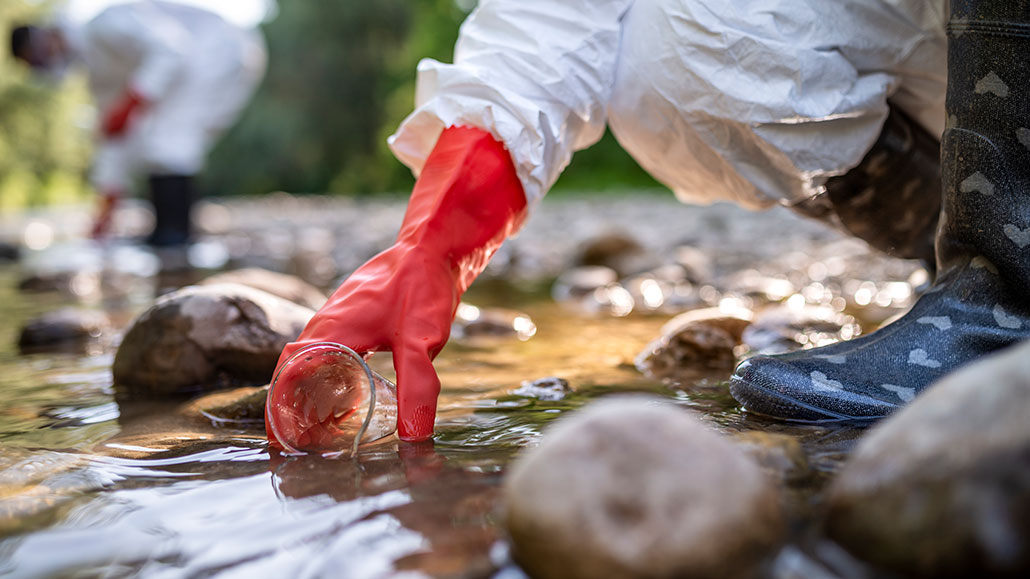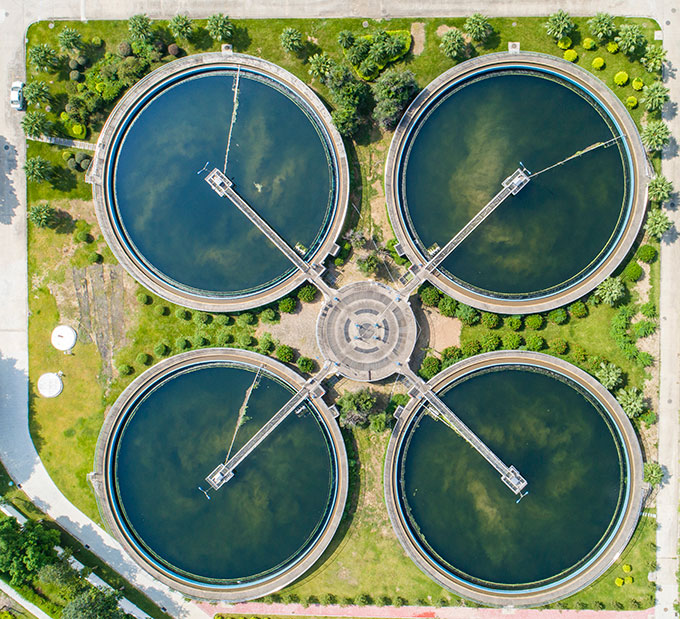Leaky sewer pipes pollute urban streams and bays with drugs
Thousands of doses of medicines flow into just the Chesapeake Bay each year, a new study shows

In one new study, scientists took weekly water samples to test for medicines polluting streams.
lovro77/E+/Getty Images Plus
By Laura Allen
The powerful drugs doctors prescribe shouldn’t end up in the water. Yet many do, a new study finds. This could be bad news for fish and other water dwellers.
For more than 20 years, scientists have known that drugs can get into streams and rivers from sewage-treatment plants. How? Some of the medicines we take come out in our pee and get flushed down the toilet. Wastewater-treatment plants were never designed to remove most of these drugs. So they pass through the plants and later get released into streams and other surface waters.
Most earlier studies sampled water coming out of those treatment plants or downstream from them. These are reliable places to find drugs.
But not all sewage makes it to the treatment plant. If an incoming pipe has a crack, dirty water can leak into the soil. Rainwater can then carry sewage into a nearby stream, including any drugs people had peed out. This new study sampled streams that did not receive treated sewage. This allowed the scientists to gauge what share of drugs in the water came from leaking pipes.
Megan Fork is an ecologist at West Chester University in Pennsylvania. She and her team sampled streams around Baltimore, Md., throughout a year. That allowed the researchers to estimate how much medicine was escaping from leaky pipes. The researchers also used existing data to calculate the quantity of drugs exiting a sewage-treatment plant that receives wastewater from this area.
Together, pollution from pipes and the plant added up to a lot medicine flowing downstream, Fork’s team found. And the leaking pipes released different concentrations of drugs than the wastewater-treatment plant did. Her team shared its findings September 7 in Environmental Science & Technology.

Even small amounts may be toxic
“Most studies on pharmaceuticals collect data once or just a few times,” Fork notes. “But we had weekly data.” That showed how the amount of drugs in the water changed over time. Sometimes the water was free of drugs. Other times it contained many types. “It was not a constant drip,” she says. “It was more like big pulses, then none at all.”
They tested for 92 different drugs. Thirty-seven turned up across all sampled streams. These included the non-prescription pain reliever Tylenol. They also included medicines used to treat fungal infections and drugs to treat depression. The drug that showed up most often was an antibiotic called trimethoprim. Overall, the more people that lived near a stream, the more drugs Fork’s team detected in its water.
The highest amount they found was less than four millionths of a gram of Tylenol per liter of water. Most samples with drugs contained just a few billionths of a gram of drug per liter of water. Some people may think tiny amounts of drugs in the water aren’t a problem. But they can be, because drugs are designed to work in tiny amounts. Fork notes that past research has shown small amounts — comparable to a few pinches of salt in an Olympic swimming pool — can harm aquatic life.
Todd Royer agrees. “It doesn’t kill organisms right away,” he notes, “but they are affected.” He is an aquatic biologist at Indiana University Bloomington. He did not take part in the new study.
After being exposed to drugs in water, crayfish are more likely to be eaten by predators. Other fish may lose the ability to reproduce. Even bacteria and algae may be affected. One seven-year study of a Canadian lake documented the near extinction of one fish species after chronic, low exposures to a hormone commonly found in birth-control pills.
Drugs in water may also build up in the bottom sediment. This slows their breakdown, which may extend how long aquatic life are exposed to the drugs.

Educators and Parents, Sign Up for The Cheat Sheet
Weekly updates to help you use Science News Explores in the learning environment
Thank you for signing up!
There was a problem signing you up.
Lots of small doses can really add up
Fork and her team wanted to understand the impacts of drug pollution on Baltimore’s Inner Harbor, which is part of the Chesapeake Bay. So the researchers calculated a year’s worth of drugs flowing into that water from the region’s streams. The results were so high that the researchers triple-checked their numbers.
They found the equivalent of 30,000 adult doses of drugs to treat depression, 1,700 doses of drugs to fight infections and 30,000 tablets of acetaminophen (Tylenol). Such numbers can now help scientists understand the big-picture effect of drugs in water.
The study also found that wastewater-treatment plants and leaking pipes spew different mixes of drugs. Overall, more drugs such as the antibiotic trimethoprim came out of the treatment plant than from leaking pipes. In fact, by their calculations, a whopping 43 percent of all trimethoprim consumed in the Baltimore metro area made it into the water. In contrast, acetaminophen came mostly from leaking pipes. Why? Treatment plants can remove most of this drug.
There is still much to learn about stream drug problems. But one thing is certain: Some of this pollution is preventable. Researchers in the United Kingdom carried out a related study. It reported evidence that many people flush their unused medicines down the toilet. “Our recent work indicated that down-the-drain disposal of pharmaceuticals doubled since the last study in 2005,” its authors say. They, too, shared their findings September 7 in Environmental Science & Technology.
Ecologists warn that people should never flush away drugs. Instead, people should turn drugs in for disposal as a hazardous waste. Or, if your community doesn’t have a drug-disposal program, the U.S. Food and Drug Administration offers guidelines for safe home disposal.
Communities must also fix leaking sewer pipes and upgrade wastewater-treatment plants to ensure the drugs that come out in pee won’t escape into our waters. “This is an important issue for anyone who cares about the animals living in the streams,” Fork says. It’s important for protecting animals in downstream waters. But keep in mind, she adds: “People taking drugs they need is not the problem.” The problem is getting communities to manage their waste properly.







